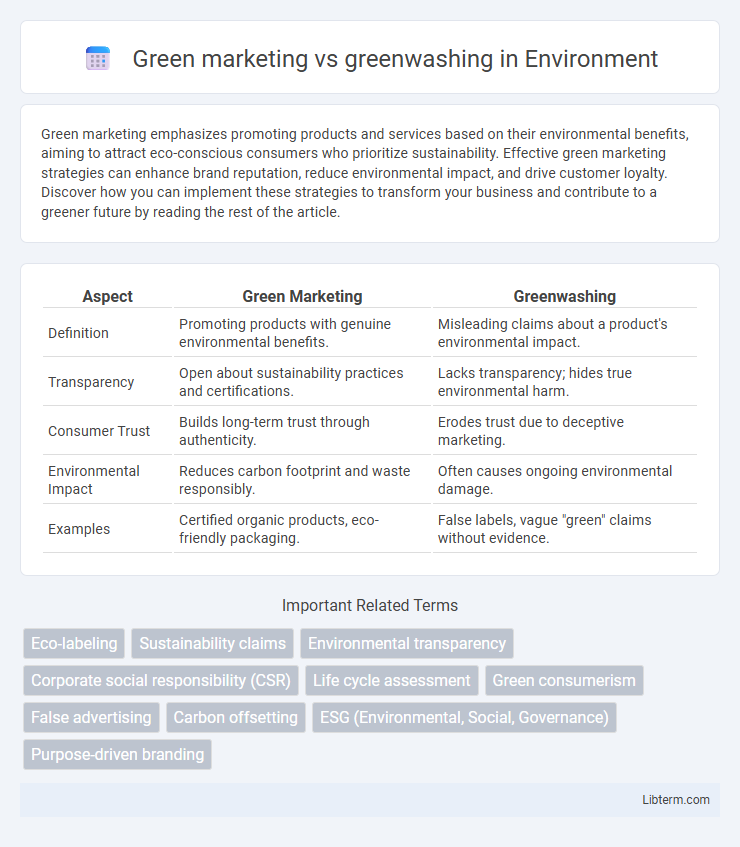Green marketing emphasizes promoting products and services based on their environmental benefits, aiming to attract eco-conscious consumers who prioritize sustainability. Effective green marketing strategies can enhance brand reputation, reduce environmental impact, and drive customer loyalty. Discover how you can implement these strategies to transform your business and contribute to a greener future by reading the rest of the article.
Table of Comparison
| Aspect | Green Marketing | Greenwashing |
|---|---|---|
| Definition | Promoting products with genuine environmental benefits. | Misleading claims about a product's environmental impact. |
| Transparency | Open about sustainability practices and certifications. | Lacks transparency; hides true environmental harm. |
| Consumer Trust | Builds long-term trust through authenticity. | Erodes trust due to deceptive marketing. |
| Environmental Impact | Reduces carbon footprint and waste responsibly. | Often causes ongoing environmental damage. |
| Examples | Certified organic products, eco-friendly packaging. | False labels, vague "green" claims without evidence. |
Understanding Green Marketing
Green marketing involves promoting products or services based on their environmental benefits, emphasizing sustainability, resource efficiency, and reduced carbon footprints to attract eco-conscious consumers. Effective green marketing requires transparent communication and verified claims about a company's environmental practices to build trust and avoid consumer skepticism. Understanding the differences between genuine green marketing and greenwashing--the deceptive practice of overstating environmental benefits--is critical for maintaining brand integrity and driving informed consumer choices.
Defining Greenwashing
Greenwashing is the deceptive practice where companies falsely promote products or policies as environmentally friendly to capitalize on consumer demand for sustainability. It involves misleading claims, vague language, or hidden trade-offs that mask the true environmental impact, undermining genuine green marketing efforts. Identifying greenwashing requires scrutiny of product certifications, transparency in supply chains, and verification of environmental benefits.
Key Differences Between Green Marketing and Greenwashing
Green marketing involves genuine efforts by companies to promote products or services with authentic environmental benefits, backed by transparent practices and credible certifications such as LEED or Energy Star. Greenwashing, by contrast, is the deceptive tactic where companies falsely claim or exaggerate environmental benefits to mislead consumers, often lacking substantiated proof or independent verification. The key differences lie in transparency, authenticity, and consumer trust, where green marketing builds brand integrity through verified sustainability claims, while greenwashing risks reputational damage and regulatory penalties due to misleading information.
The Importance of Authentic Sustainability Claims
Authentic sustainability claims build consumer trust by transparently showcasing genuine eco-friendly practices and verifiable environmental benefits. Green marketing effectively differentiates brands committed to reducing carbon footprints, utilizing renewable resources, and promoting circular economy models from those employing deceptive greenwashing tactics. Emphasizing credible certifications and third-party audits ensures that sustainability messaging fosters long-term brand loyalty and drives meaningful environmental impact.
Common Greenwashing Tactics to Watch Out For
Common greenwashing tactics include vague or misleading claims such as "eco-friendly" without certification, using irrelevant labels that imply environmental benefits, and highlighting a single green attribute while ignoring harmful practices elsewhere in the product lifecycle. Companies often use false or exaggerated environmental certifications and employ imagery of nature to create a deceptive impression of sustainability. Consumers should scrutinize product transparency, third-party certifications like USDA Organic or Fair Trade, and detailed environmental impact reports to avoid being misled by greenwashing.
Benefits of Genuine Green Marketing Strategies
Genuine green marketing strategies enhance brand credibility by demonstrating a company's commitment to sustainable practices, which attracts environmentally conscious consumers and builds long-term customer loyalty. These strategies often lead to cost savings through improved resource efficiency and waste reduction, boosting overall profitability. Transparency and authentic environmental accountability differentiate brands from competitors engaging in greenwashing, fostering trust and positive reputation in the growing green economy.
The Impact of Greenwashing on Consumer Trust
Greenwashing significantly undermines consumer trust by misleading buyers with false or exaggerated environmental claims, leading to skepticism towards genuinely sustainable brands. Studies show that when consumers detect greenwashing, their overall confidence in environmental marketing diminishes, reducing willingness to pay premiums for eco-friendly products. Building transparent and verifiable green marketing strategies is essential to restore and maintain long-term consumer loyalty and promote authentic sustainability.
Regulatory Guidelines and Standards for Green Marketing
Regulatory guidelines for green marketing require companies to provide transparent, verifiable claims about environmental benefits, preventing misleading practices known as greenwashing. Standards such as the Federal Trade Commission's Green Guides in the U.S. and ISO 14021 for environmental labels enforce stringent criteria for accuracy and substantiation in green marketing communications. Compliance with these regulations ensures that businesses promote genuine sustainability efforts while protecting consumers from deceptive environmental claims.
How to Identify Authentic Green Brands
Authentic green brands demonstrate transparent sustainability practices through verified certifications such as USDA Organic, Fair Trade, or B Corp status, and provide detailed information about their supply chain and environmental impact. They invest in measurable eco-friendly initiatives like carbon footprint reduction, renewable energy usage, and waste minimization, differentiating themselves from greenwashing, which often relies on vague claims and misleading labels. Consumer trust is bolstered when brands openly report third-party audits and lifecycle assessments, reflecting genuine commitment to environmental responsibility rather than superficial marketing tactics.
Future Trends in Eco-Friendly Marketing Practices
Future trends in eco-friendly marketing practices emphasize authentic sustainability through transparent communication and verified green certifications to combat greenwashing. Companies increasingly invest in life cycle assessments and circular economy models to demonstrate genuine environmental impact reduction. Advanced technologies like blockchain enable traceability and consumer trust, reinforcing credibility in green marketing initiatives.
Green marketing Infographic

 libterm.com
libterm.com